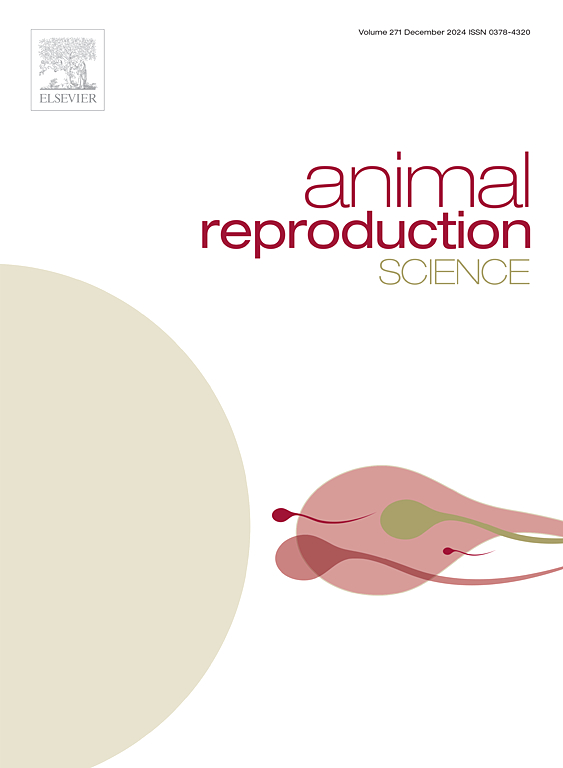野生六带犰狳(Euphractus sexcinctus)的药理学辅助精液采集及精子形态评价方法
IF 2.2
2区 农林科学
Q1 AGRICULTURE, DAIRY & ANIMAL SCIENCE
引用次数: 0
摘要
六带犰狳(Euphractus sexcinctus)是一种非濒危物种,为开发辅助生殖技术以保护濒危物种提供了有价值的实验模型。然而,有限的知识,他们的生殖生物学提出了一个关键的挑战。本研究旨在评估药理学精液采集方案的有效性,并比较使用明场显微镜(KA)、相对比显微镜(PC)和差示干涉对比显微镜(DIC)对精子形态进行评估的卡拉斯改良染色。捕获20只自由放养的雄性六带犰狳,并给予以下药物镇静方案:酒石酸丁托啡诺、盐酸托咪定和盐酸咪达唑仑(i.m, 0.1 mg/kg)。给药十分钟后,沿着阴茎从底部到尖端轻轻地按压精液。排出的精液积聚在尿道窝,用可变体积的微移液管收集,并评估宏观和微观特征。95%的雄性表现出部分射精,没有观察到令人厌恶的行为或不适的迹象。大多数精液样本(83% %)含有超过30% %的形态异常精子,精子缺陷概况具有相当大的个体差异。虽然所有的显微镜技术都可以有效地评估精子形态,但KA在识别顶体完整性和头部异常方面是最有效的。该方法提供了一种实用且具有成本效益的解决方案,特别适合于现场条件。本研究报告了第一个成功的六带犰狳精液采集药理学方案,突出了其在生殖评估中的潜在应用,并有助于制定相关物种的保护策略。本文章由计算机程序翻译,如有差异,请以英文原文为准。
Pharmacologically assisted semen collection and sperm morphology assessment methods in wild six-banded armadillos (Euphractus sexcinctus)
Six-banded armadillos (Euphractus sexcinctus), a non-endangered species, serve as a valuable experimental model for developing assisted reproductive technologies aimed at conserving endangered species within the order Cingulata. However, limited knowledge of their reproductive biology presents a critical challenge. This study aimed to evaluate the effectiveness of a pharmacological semen collection protocol and compare Karras-modified staining using brightfield microscopy (KA), phase contrast microscopy (PC), and differential interference contrast microscopy (DIC) for assessing sperm morphology. Twenty free-ranging male six-banded armadillos were captured and subjected to the following pharmacological sedation protocol: butorphanol tartrate, detomidine hydrochloride and midazolam hydrochloride (i.m., 0.1 mg/kg each). Ten minutes after administration, semen was extracted by applying gentle pressure along the penis, from its base to the tip. The expelled semen, which accumulated into the urethral fossa, was collected using a variable-volume micropipette and assessed for macro and microscopic characteristics. Ninety-five percent of the males exhibited a partial ejaculation, with no aversive behavior or signs of discomfort observed. Most semen samples (83 %) contained more than 30 % of morphologically abnormal sperm with considerable individual variability in sperm defect profiles. While all microscopy techniques allowed effective assessment of sperm morphology, KA was the most efficient in identifying acrosome integrity and head abnormalities. This method offers a practical and cost-effective solution, particularly suited for field conditions. This study reports the first successful pharmacological protocol for semen collection in six-banded armadillos, highlighting its potential use for reproductive assessments and contributing to developing conservation strategies for related species.
求助全文
通过发布文献求助,成功后即可免费获取论文全文。
去求助
来源期刊

Animal Reproduction Science
农林科学-奶制品与动物科学
CiteScore
4.50
自引率
9.10%
发文量
136
审稿时长
54 days
期刊介绍:
Animal Reproduction Science publishes results from studies relating to reproduction and fertility in animals. This includes both fundamental research and applied studies, including management practices that increase our understanding of the biology and manipulation of reproduction. Manuscripts should go into depth in the mechanisms involved in the research reported, rather than a give a mere description of findings. The focus is on animals that are useful to humans including food- and fibre-producing; companion/recreational; captive; and endangered species including zoo animals, but excluding laboratory animals unless the results of the study provide new information that impacts the basic understanding of the biology or manipulation of reproduction.
The journal''s scope includes the study of reproductive physiology and endocrinology, reproductive cycles, natural and artificial control of reproduction, preservation and use of gametes and embryos, pregnancy and parturition, infertility and sterility, diagnostic and therapeutic techniques.
The Editorial Board of Animal Reproduction Science has decided not to publish papers in which there is an exclusive examination of the in vitro development of oocytes and embryos; however, there will be consideration of papers that include in vitro studies where the source of the oocytes and/or development of the embryos beyond the blastocyst stage is part of the experimental design.
 求助内容:
求助内容: 应助结果提醒方式:
应助结果提醒方式:


